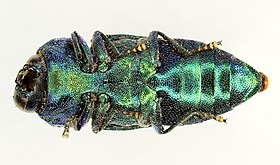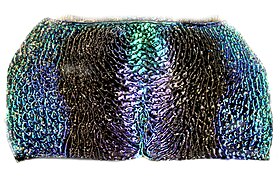Anthaxia passerinii
| Anthaxia passerinii | ||||||||||||
|---|---|---|---|---|---|---|---|---|---|---|---|---|

Anthaxia passerinii |
||||||||||||
| Systematics | ||||||||||||
|
||||||||||||
| Scientific name | ||||||||||||
| Anthaxia passerinii | ||||||||||||
| Pecchioli , 1837 |
Anthaxia passerinii (often incorrectlyspelled Anthaxia passerini ) is a beetle fromthe jewel beetle family and the subfamily Buprestinae . The genus Anthaxia is represented in Europe with four subgenus, Anthaxia passerinii becomes the subgenus Anthaxia s. s. calculated, which is represented in Europe with 47 species. The species of the Anthaxia passerinii group are most closely related to the species of the Anthaxia candens group.
The beetle does not occur in Central Europe.
Comments on the initial description and synonyms
The beetle was caught by Vittorio Pecchioli near Florence . Pecchioli does not explicitly mention it in the description of the beetles, but the beetle is probably named after Pecchioli's contemporary, Carlo Passerini , coleopterologist and curator at the Imperial and Royal Museum of Physics and Natural History of Florence (now the Museo di Storia Naturale ). Pecchioli sent the description of the beetle to Paris to the Entomological Society of France. In the Annals of the Society, the description was published in 1837.
Synonyms are not known.
Properties of the beetle
The beetle is a relatively large member of the genus with a length of six to eight millimeters and a width of around two millimeters. It belongs to the flat species. Among the many similar species of the genus, the colorful beetle is characterized by the clear separation of the differently colored areas from each other. The head is gold green to gold blue, the throat plate of the same color with two black, dimly defined longitudinal bands, the elytra copper having a relatively sharply defined green triangle coincides its base connected to the base of the elytra and its tip on the elytra seam a little before the first third lies. Anthaxia semicuprea , Anthaxia croesus , Anthaxia olympica , Anthaxia praeclara , Anthaxia salicis , Anthaxia fulgurans , Anthaxia suzannae and Anthaxia scutellaris have a similar coloring in at least one sex . In contrast to the majority of the species in the genus, males and females are colored the same.
The head is tilted downwards. It is densely haired with fine white hair and very densely finely dotted. The eyes are big and dark. The distance from the posterior edge of the eye to the pronotum is very small. The eleven-link, narrow and inwardly sawn antennae are short, they only reach the middle of the pronotum .
The upper lip is bilobed, the strong upper jaws are strongly curved and tapering to a point. There is a large blunt tooth on the inside. The four-link jaw buttons are thread-shaped, the end link cylindrical and trimmed. The last link of the three-part lip switch is also cylindrical and trimmed.
The pronotum (Fig. 3) is 1.9 times as wide as it is long. The sides are strongly rounded and slightly bent up at the rear corner. The fine dots are not even. The points sit individually on the sides in round cells with granules, along the middle there are several points between transverse wrinkles, and in between the wrinkles run in an arched shape, open to the front, or lengthways. In the middle of the pronotum there is a flat longitudinal impression, which is flanked by two blurry black bands that run parallel to each other.
The label is relatively large, black and triangular to slightly heart-shaped.
The wing covers (Fig. 4) are relatively short and pointed backwards compared to similar species. They are 1.65 to 1.7 times as long as they are together wide. The sides of the elytra are slightly curved and the edge is sawed almost imperceptibly towards the end (clearly visible at the top right in Fig. 4 when fully enlarged). The beetles are also dense and finely dotted on the wing covers, resulting in small transverse wrinkles that are much less pronounced than on the pronotum. From the base points of the green triangle, a curved, flat channel runs on each wing cover almost to the wing tip, the area between the channels is slightly elevated. Not only the triangle at the base of the wing coverts, but also the side edge of the wing coverts is green, at least in the front area, as is the adjacent area under the shoulders and behind it.
The entire underside is bright gold-green (Fig. 2). The anal sternite is rounded in both sexes and slightly truncated at the end, more pronounced in the males than in the females.
biology
The larvae develop in juniper and cypress trees . Conifers as host plants are uncommon within the subgenus Anthaxia . The adults are often found on roses from April to June, they were also found on wild apples and ruderal fauna (including taxo picture).
Macquart names the species as the chamomile beetle . In the first description of Pecchioli, Camomillaceae (out of date, camomile-like) is also given as the site.
When cypresses were examined in Montenegro , the species was classified as a secondary pest that has already attacked weakened or dead trees, for example with Buprestis cupressi . The larva creates winding tunnels under the bark.
Occurrence
Although the species was first described in Italy from the Florence area , it is rare in Italy today. The distribution area extends from Italy through the Balkans , Greece , Asia Minor , the Caucasus to the west of Turkmenistan .
Individual evidence
- ↑ Anthaxia (subgenus) in Fauna Europaea. Retrieved February 25, 2016
- ↑ Anthaxia at Fauna Europaea. Retrieved February 25, 2016
- ↑ a b c Svatopluk Bílý: "A revision of Anthaxia passerini (Pecchioli) species-group (Coleoptera, Buprestidae)" in Acta entomologica bohemoslovaca vol. 79 Prague 1982, p. 221 ff
- ^ A b c M. Pecchioli: Déscriptions de deux coléoptères nouveaux d'Italie in Annales de la Société Entomologique de France tome 6 Paris, Strasbourg 1837 First description p. 446 Mention of the letter S. LXXV
- ↑ Gustav Jäger (Ed.): CG Calwer’s Käferbuch . K. Thienemanns, Stuttgart 1876, 3rd edition, p. 333
- ↑ H.Mühle, P. Brandl, M. Niehuis: Catalogus Faunae Graeciae; Coleoptera: Buprestidae Printed in Germany by Georg Rößle Augsburg 2000
- ↑ Şebnem Karaman, Serdar Tezcan: "Contribution to the study of the genus Anthaxia (Subgenus Anthaxia s. Str. ) Eschscholtz 1829 (Coleoptera, Buprestidae) of Turkey" Turk. entomol. derg., 1998, 22 (1): 19-35 ISSN 1010-6960 p. 29
- ↑ J. Macquart: Plantes herbacées d'Europe et leurs insectes third part in Memoires de la Societe Imperiale des Sciences de l'agriculture et des arts de Lille . 2nd Series, Vol 2, Lille 1855 S. 401
- ↑ Dragan Roganović: "Insects on trunk and branches of cypress ( Cupressus sempervirens L.) in Montenegro" ION TRUNK, BOF CYPRESS - webhost.rcub.bg.ac.rs JULY – DECEMBER, 2007. 55 UDK 630 * 453: 582. 477 (497. 16) Originalni nauøni rad [1]
- ↑ Gianfranco Curletti: Coleotteri Buprestidi del Piemonte e Valle d'Aosta Riv. Piem. St. Nat., 1, 1980 p. 83



